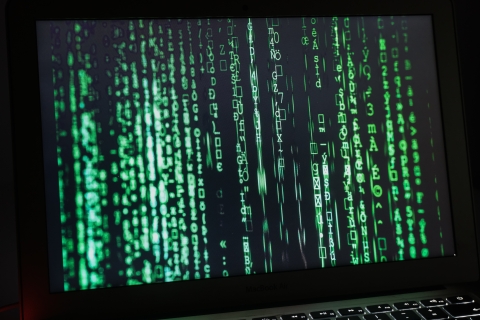

If the average amount of information conveyed by an event is always decreasing, it could mean we live in a computer program.
4 min read
The simulated universe theory implies that our universe, with all its galaxies, planets and life forms, is a meticulously programmed computer simulation. In this scenario, the physical laws governing our reality are simply algorithms. The experiences we have are generated by the computational processes of an immensely advanced system.
While inherently speculative, the simulated universe theory has gained attention from scientists and philosophers due to its intriguing implications. The idea has made its mark in popular culture, across movies, TV shows and books – including the 1999 film The Matrix.
The earliest records of the concept that reality is an illusion are from ancient Greece. There, the question “What is the nature of our reality?”, posed by Plato (427 BC) and others, gave birth to idealism. Idealist ancient thinkers such as Plato considered mind and spirit as the abiding reality. Matter, they argued, was just a manifestation or illusion.
Fast forward to modern times, and idealism has morphed into a new philosophy. This is the idea that both the material world and consciousness are part of a simulated reality. This is simply a modern extension of idealism, driven by recent technological advancements in computing and digital technologies. In both cases, the true nature of reality transcends the physical.
Within the scientific community, the concept of a simulated universe has sparked both fascination and scepticism. Some scientists suggest that if our reality is a simulation, there may be glitches or patterns within the fabric of the universe that betray its simulated nature.
However, the search for such anomalies remains a challenge. Our understanding of the laws of physics is still evolving. Ultimately, we lack a definitive framework to distinguish between simulated and non-simulated reality.
A new law of physics
If our physical reality is a simulated construct, rather than an objective world that exists independently of the observer, then how could we scientifically prove this? In a 2022 study, I proposed a possible experiment, but it remains untested today.
However, there is hope. Information theory is the mathematical study of the quantification, storage and communication of information. Originally developed by mathematician Claude Shannon, it has become increasingly popular in physics and is used a growing range of research areas.
In my recent research, published in AIP Advances, I used information theory to propose a new law of physics, which I call the second law of infodynamics. And importantly, it appears to support the simulated universe theory.
At the heart of the second law of infodynamics is the concept of entropy – a measure of disorder, which always rises over time in an isolated system. When a hot cup of coffee is left on the table, after a while it will achieve equilibrium, having the same temperature with the environment. The entropy of the system is at maximum at this point, and its energy is minimum.
The second law of infodynamics states that the “information entropy” (the average amount of information conveyed by an event), must remain constant or decrease over time – up to a minimum value at equilibrium.
So it is in total opposition to the second law of thermodynamics (that heat always flows spontaneously from hot to cold regions of matter while entorpy rises). For a cooling cup of coffee, it means that the spread of probabilities of locating a molecule in the liquid is reduced. That’s because the spread of energies available is reduced when there’s thermal equilibrium. So information entropy always goes down over time as entropy goes up.
My study indicates that the second law of infodynamics appears to be a cosmological necessity. It is universally applicable with immense scientific ramifications. We know the universe is expanding without the loss or gain of heat, which requires the total entropy of the universe to be constant. However we also know from thermodynamics that entropy is always rising. I argue this shows that there must be another entropy – information entropy – to balance the increase.
My law can confirm how genetic information behaves. But it also indicates that genetic mutations are at the most fundamental level not just random events, as Darwin’s theory suggests. Instead, genetic mutations take place according to the second law of infodynamics, in such a way that the genome’s information entropy is always minimised. The law can also explain phenomena in atomic physics and the time evolution of digital data.
Most interestingly, this new law explains one of the great mysteries of nature. Why does symmetry rather than asymmetry dominate the universe? My study demonstrates mathematically that high symmetry states are the preferred choice because such states correspond to the lowest information entropy. And, as dictated by the second law of infodynamics, that’s what a system will naturally strive for.
I believe this discovery has massive implications for genetic research, evolutionary biology, genetic therapies, physics, mathematics and cosmology, to name a few.
Simulation theory
The main consequence of the second law of infodynamics is the minimisation of the information content associated with any event or process in the universe. This in turn means an optimisation of the information content, or the most effective data compression.
Dr Melvin Vopson is a Senior Lecturer at the School of Mathematics and Physics in the Faculty of Technology.
This article is republished from The Conversation under a Creative Commons Licence. Read the original article.
More The Conversation Articles...
The Conversation is an independent source of news analysis and informed comment written by academic experts, working with professional journalists who help share their knowledge with the world.
The book that haunts me – seven experts on the scariest thing they’ve ever read
The book that haunts me – seven experts on the scariest thing they’ve ever read
19 October 2023
4 min read

Osiris-Rex: Nasa reveals evidence of water and carbon in sample delivered to Earth from an asteroid
Dr Lucinda King
13 October 2023
3 min read

Hamas: what you need to know about the group that attacked Israel
12 October 2023
3 min read

